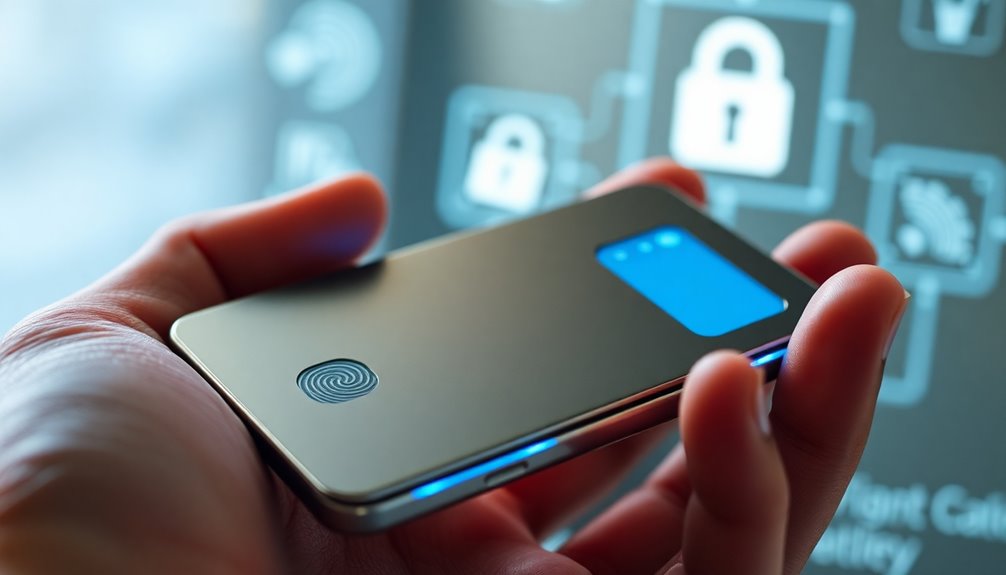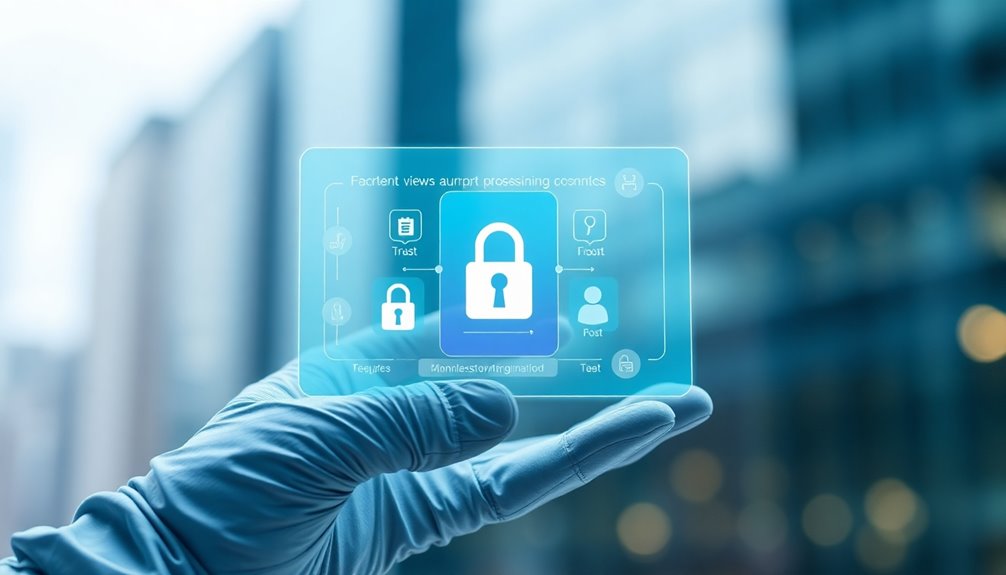Digital ID wallets balance security and convenience by combining biometric and multi-factor authentication with advanced encryption and tamper-proof storage. Decentralized identifiers give you control over your data, while facial recognition speeds up verification. Although strong security measures protect your information, easy access features improve daily use. If you’re interested, you’ll discover how new technologies and trust practices help you stay safe without sacrificing ease of access.
Key Takeaways
- Strong encryption and tamper-proof storage protect digital IDs, enhancing security but may add complexity to user access.
- Biometric authentication offers quick access but requires robust liveness detection to prevent spoofing risks.
- Decentralized identifiers give users control, balancing privacy with the convenience of seamless, cross-platform access.
- Multi-factor authentication improves security but might slightly slow down the verification process.
- User-centric privacy controls enable minimal data sharing, maintaining security without compromising user convenience.
Enhancing Security With Biometric and Multi-Factor Authentication

Enhancing security in digital ID wallets has become increasingly critical as more people rely on mobile devices to store sensitive information. Biometric authentication, such as fingerprint scans, facial recognition, and iris scans, offers a convenient way to verify your identity securely. Advanced systems include liveness detection to prevent spoofing, ensuring you’re the real user. As familiarity with biometric methods grows, so does their acceptance, especially since modern devices make the hardware affordable and accessible. Incorporating color accuracy in biometric sensors can improve recognition performance under different lighting conditions. Improving sensor durability ensures long-term reliability of biometric components, even with frequent use. Additionally, selecting high-quality sensors with power efficiency can extend device battery life during authentication processes. Combining biometrics with multi-factor authentication adds further security layers—like passwords or cryptographic keys—making it harder for unauthorized users to access your data. As the integration of AI technology in biometric systems advances, they become more adaptive and resistant to fraud. While privacy concerns exist, many find the security benefits compelling, and ongoing technological advances help balance security with user convenience.
The Role of Advanced Encryption and Tamper-Proof Storage

Advanced encryption and tamper-proof storage are essential for securing digital ID wallets against unauthorized access and manipulation. Encryption scrambles your data with complex algorithms, ensuring only those with the correct decryption keys can read it. Techniques like advanced encryption methods protect sensitive information stored within your wallet, whether stored centrally or in decentralized systems that reduce hacking risks. Tamper-proof storage, often built on blockchain technology, creates permanent, unchangeable records, making it impossible to alter credentials fraudulently. This system gives you control over your private keys, eliminating single points of failure and increasing resilience. Additionally, implementing sound design principles in security interfaces can improve user understanding and trust in the system. Incorporating user-centric design can further enhance security by making complex features accessible and easier to use, reducing user errors. Employing encryption protocols aligned with industry standards helps ensure robust protection against evolving threats. Furthermore, adopting multi-factor authentication adds an extra layer of security by requiring multiple verification methods. Integrating key management solutions can streamline the secure handling of cryptographic keys and prevent unauthorized access. Together, encryption and tamper-proof storage boost data integrity, protect against breaches, and foster user trust by ensuring your digital identities remain private, secure, and trustworthy.
Privacy Preservation Through Decentralized Identifiers

Decentralized Identifiers (DIDs) revolutionize privacy preservation by giving you full control over your digital identity without relying on centralized authorities. You manage your identifiers directly, reducing risks from single points of failure and third-party breaches. DIDs enable you to selectively disclose only the necessary information, safeguarding your privacy. Cryptographic techniques like zero-knowledge proofs allow you to verify credentials without revealing sensitive details. Data is stored in secure, separate compartments, minimizing exposure. Blockchain integration ensures transparent, tamper-proof management of your identifiers. With DIDs, you own and control your data, deciding what to share and with whom. This user-centric approach enhances privacy, minimizes data breaches, and aligns with privacy regulations, making your digital identity more secure and private.
The Convenience of Accessibility and Portability in Daily Use

Digital ID wallets make it easy for you to access your credentials across multiple devices and platforms, giving you greater flexibility in your daily life. You can smoothly switch between your smartphone, tablet, or laptop, no matter the operating system, thanks to cross-platform compatibility. Cloud synchronization ensures your credentials are always up to date, reducing manual updates, while offline access lets you verify your identity even without internet. These wallets also consolidate multiple physical cards—driver’s licenses, passports, insurance—into a single digital interface, reducing bulk and minimizing the risk of losing important documents. Additionally, digital keys replace bulky traditional keys, making it easier to access your home, office, or vehicle. As the demand for digital security grows, these wallets are becoming essential tools for safeguarding personal information. Incorporating secure encryption protocols further enhances the protection of your data. Implementing biometric authentication adds an extra layer of security, ensuring only authorized users can access sensitive information. Moreover, understanding the benefits of encryption can help users appreciate how their data remains protected from unauthorized access. Staying informed about privacy policies is also crucial for maintaining control over your personal data. Overall, digital ID wallets streamline your daily routines, making identity verification faster, more convenient, and more organized.
Streamlining Verification Processes With Facial Recognition Technology

Facial recognition technology considerably accelerates verification processes, making identity checks faster and more seamless. Near-instant authentication reduces typical times from minutes to seconds, streamlining high-traffic environments like airports. Contactless operation eliminates the need to handle physical documents, speeding up throughput. Automated liveness checks prevent spoofing with minimal user effort, simply requiring a glance at the camera. Seamless integration with mobile wallets allows you to verify your identity directly from your smartphone, bypassing manual data entry. Batch processing capabilities enable institutions to verify multiple identities simultaneously during peak demand. These features combine to create quick, secure verification, enhancing user experience in various settings. As a result, facial recognition technology transforms traditional verification into a swift, contactless process that’s both efficient and reliable. Compatibility factors also influence the effectiveness of facial recognition systems, ensuring accurate authentication across diverse populations. Additionally, ongoing advancements in AI-driven security systems help address emerging threats and improve overall system robustness. Furthermore, regular updates and system calibration are essential to maintain high accuracy levels over time. Incorporating Nissan tuning techniques can inspire innovations in biometric security hardware, pushing the boundaries of performance and reliability.
Balancing User Control and Data Transparency

Balancing user control with data transparency is essential for building trust in digital ID wallets. You can selectively share only the necessary data for each transaction, guaranteeing minimal disclosure. All data sharing requires your explicit consent, which you can revoke at any time, and access is granted temporarily to prevent indefinite retention. Audit trails let you review who accessed your data and when. Compliance frameworks like GDPR and HIPAA ensure your rights are protected and data processed lawfully. Cryptographic tools such as zero-knowledge proofs and end-to-end encryption safeguard your information in transit and at rest. Transparency is further enhanced through open-source components, third-party audits, and real-time logs, empowering you to monitor and control your data while maintaining operational integrity. Data protection strategies ensure your information remains secure while you enjoy the benefits of digital ID wallets. Average prices for vetted – Grace for Life Designs solutions ensure reliable security without excessive costs.
Technological Innovations Driving Secure and User-Friendly Digital IDs

Recent technological innovations are transforming how digital ID wallets guarantee security while remaining user-friendly. Biometrics like facial recognition, fingerprints, and iris scans ensure only you can access your digital ID, reducing unauthorized use. Combining biometrics with PINs or device authentication creates multi-factor protection that’s both secure and seamless, especially during quick verifications like at TSA. Advances in biometric sensors improve accuracy and user convenience. Encryption techniques protect your sensitive data through advanced algorithms, making sure your information stays private during storage and transmission. Decentralized identifiers and blockchain technology give you control over your data, reducing reliance on central authorities and enhancing privacy. Verifiable credentials, with cryptographic signatures and selective disclosure, allow you to share only what’s necessary, safeguarding your privacy while simplifying identity verification. Implementing mindfulness techniques can further enhance user focus and reduce stress during digital interactions, promoting a more balanced approach to technology use. Additionally, integrating data privacy best practices ensures that users’ information remains protected against potential breaches while maintaining ease of access.
Navigating Risks and Building Trust in Digital Identity Solutions

Building trust in digital identity solutions requires addressing a range of security and privacy risks that can undermine user confidence. Data breaches and hacking threaten sensitive information, while lost devices can give thieves direct access without proper safeguards. Social engineering tricks users into revealing credentials, and vulnerabilities in third-party services create systemic weaknesses. Unsecured transmissions expose data during transfer. Privacy challenges include steering through complex regulations like GDPR, preventing purpose creep, and avoiding surveillance risks from centralized systems. Technical vulnerabilities such as rooted devices, weak authentication, or outdated encryption heighten risks. Infrastructure issues like vendor lock-in or legacy system incompatibility can compromise security. To build trust, organizations must implement transparent policies, multi-party oversight, robust encryption, and clear breach protocols, ensuring users feel confident in their digital identities.
Frequently Asked Questions
How Do Digital ID Wallets Protect Against Biometric Data Theft?
You might wonder how digital ID wallets guard against biometric data theft. They use advanced encryption and biometric authentication to keep your data secure. You control access through multi-factor authentication and selective sharing, ensuring only you decide what’s shared. Secure storage and local data processing reduce exposure, while regular updates and monitoring help detect threats early. These measures work together to protect your biometric information effectively.
Can Multi-Factor Authentication Be Inconvenient for Users?
Yes, MFA can be inconvenient for you. It often adds extra steps, making login processes longer and more complex. You might find captcha codes or verification prompts frustrating and time-consuming. While it offers better security, these extra steps can disrupt your workflow and cause annoyance. Many users feel the inconvenience outweighs the benefits, but understanding that MFA helps protect your accounts can make it worth the effort.
Are Decentralized Identifiers Completely Immune to Hacking?
Are decentralized identifiers completely immune to hacking? Not quite. While DIDs leverage advanced security features like cryptographic keys, distributed ledgers, and tamper-proof transactions, they’re not invulnerable. Private key management remains a critical vulnerability—if you lose or compromise your keys, your identity could be at risk. Plus, reliance on centralized nodes for resolution and emerging web vulnerabilities can still pose threats. So, stay vigilant—no system is entirely hack-proof.
How Do Digital IDS Handle Data Breaches or System Failures?
When a data breach or system failure occurs, digital IDs rely on several protections. You’re informed through user notifications, and service providers suspend wallets if security issues arise. They work with stakeholders to fix vulnerabilities quickly, following strict legal and regulatory standards. Regular testing, updates, and backup systems help minimize risks, ensuring your data remains protected and that you experience minimal disruption during any system issues.
What Regulations Govern the Privacy and Security of Digital ID Wallets?
Think of regulations as the sturdy shield guarding your digital identity. You’re protected by the EU’s GDPR, which enforces strict data privacy and consent rules, and the US’s NIST guidelines, focusing on security controls. These laws demand encryption, user control over data sharing, and transparency. They also require regular security audits, ensuring your digital wallet remains a fortress against breaches while respecting your rights to privacy and data control.
Conclusion
As you navigate the world of digital ID wallets, think of them as a finely balanced tightrope—juggling security and convenience. With cutting-edge tech like biometrics and encryption, you’re holding a powerful key to both safety and ease. But remember, trust is your safety net. As technology evolves, stay vigilant and informed, so your digital identity remains a fortress wrapped in a cloak of simplicity—letting you stride confidently into the future.









